A Core Flood and Microfluidics Investigation of Nanocellulose as a Chemical Additive to Water Flooding for EOR
Abstract
1. Introduction
2. Materials
2.1. Rock
2.2. Microfluidic Chip
2.3. Brine
2.4. Nanocelluloses
2.4.1. Cellulose Nanocrystals
2.4.2. TEMPO-Oxidized Cellulose Nanofibrils
2.5. Oil
3. Experimental Methods
3.1. Fluid Interaction Measurements
3.1.1. Fluid-Fluid Interactions
3.1.2. Fluid-Solid Interactions
3.2. Core Flood Study
3.2.1. Experimental Setup
3.2.2. Core Flood Experiments
3.2.3. Core Flood Procedure
3.2.4. Aging
3.3. Microfluidic Study
3.3.1. Experimental Setup
3.3.2. Microfluidics Experiments
3.3.3. Microfluidic Procedure
3.3.4. Image Processing and Analysis
4. Results and Discussion
4.1. Fluid-Fluid Interactions
4.2. Fluid-Solid Interactions
4.3. Capillary Number
4.4. Core Flood
4.4.1. Part 1
4.4.2. Part 2
Secondary Recovery
Tertiary Recovery
4.4.3. Part 3
T-CNF and CNC Concentration
Oil Recovery Experiment
4.5. Microfluidics
5. Conclusions
- The interfacial tension and contact angle values were dependent upon the crude oil type and nanoparticle type that was used. Overall, the IFT was not altered by the addition of T-CNF nanoparticles, but a small decrease in IFT was observed when CNCs were employed. For the contact angle, a slight increase in value was observed when CNCs or T-CNFs were added to the LSW. However, the change was marginal, thus, wettability alteration is not a primary EOR mechanism.
- For the secondary mode experiment where the core was re-used, the wettability restoration method was considered successful since it led to the same irreducible water saturation after primary drainage. From the oil recovery experiment, nanofluid yielded 5.8% of OOIP more oil, compared to low salinity water.
- CNC nanoparticles were able to extract 2–27% of OOIP more oil than LSW when injected as a secondary technique. Furthermore, the particles appeared to perform better under mixed-wet conditions.
- The oil recovery was enhanced when CNC nanofluid was injected as a tertiary recovery technique, where more incremental oil was produced for the high-temperature floods. For the tertiary floods, there did not seem to be an overall trend regarding rock wettability and oil recovery.
- Looking at the effect of particle type, T-CNFs were much more effective than CNCs to recover trapped oil. This was evident from both core flooding and microfluidic experiments. However, the pressure was constantly increasing during the high rate T-CNF core flood. Even though more oil was recovered during the T-CNF flood, the high pressure indicates poor injectivity. Furthermore, filtering of particles was observed on the inlet side of the core plug after the experiment. Future experiments should, therefore, test T-CNFs at a lower concentration, to see if a similar high incremental oil recovery can be achieved with a lower and more stable pressure profile.
- The microfluidic experiments supported the findings from the core floods, with nanofluid leading to a better sweep efficiency compared to low salinity flooding. T-CNFs improved the oil recovery the most, by breaking up large oil clusters and mobilizing them. Looking at the effect of the flow rate, it was evident that a higher flow rate resulted in lower oil recovery factors and higher remaining oil connectivity.
Author Contributions
Funding
Acknowledgments
Conflicts of Interest
References
- Muggeridge, A.; Cockin, A.; Webb, K.; Frampton, H.; Collins, I.; Moulds, T.; Salino, P. Recovery rates, enhanced oil recovery and technological limits. Philos. Trans. R. Soc. A 2014, 372, 20120320. [Google Scholar] [CrossRef]
- Available online: https://www.regjeringen.no/globalassets/upload/oed/pdf_filer_2/faktaheftet/fakta2014og/facts_2014_nett_.pdf (accessed on 7 April 2014).
- Aadland, R.C.; Jakobsen, T.D.; Heggset, E.B.; Long-Sanouiller, H.; Simon, S.; Paso, K.G.; Syverud, K.; Torsæter, O. High-temperature core flood investigation of nanocellulose as a green additive for enhanced oil recovery. Nanomaterials 2019, 9, 665. [Google Scholar] [CrossRef] [PubMed]
- Jakobsen, T.D.; Simon, S.b.; Heggset, E.B.; Syverud, K.; Paso, K.J.I.; Research, E.C. Interactions between surfactants and cellulose nanofibrils for enhanced oil recovery. Ind. Eng. Chem. Res. 2018, 57, 15749–15758. [Google Scholar] [CrossRef]
- Kusanagi, K.; Murata, S.; Goi, Y.; Sabi, M.; Zinno, K.; Kato, Y.; Togashi, N.; Matsuoka, T.; Liang, Y. Application of cellulose nanofiber as environment-friendly polymer for oil development. In Proceedings of the SPE/IATMI Asia Pacific Oil & Gas Conference and Exhibition, Nusa Dua, Bali, Indonesia, 20–22 October 2015. [Google Scholar]
- Molnes, S.N.; Mamonov, A.; Paso, K.G.; Strand, S.; Syverud, K. Investigation of a new application for cellulose nanocrystals: A study of the enhanced oil recovery potential by use of a green additive. Cellulose 2018, 25, 2289–2301. [Google Scholar] [CrossRef]
- Molnes, S.N.; Torrijos, I.P.; Strand, S.; Paso, K.G.; Syverud, K. Sandstone injectivity and salt stability of cellulose nanocrystals (CNC) dispersions—Premises for use of CNC in enhanced oil recovery. Ind. Crop. Prod. 2016, 93, 152–160. [Google Scholar] [CrossRef]
- French, A.; Bertoniere, N.; Brown, R.; Chanzy, H.; Gray, D.; Hattori, K.; Kirk-Othmer, G. Encyclopedia of Chemical Technology; Seidel, A., Ed.; John Wiley Sons, Inc.: Hoboken, NJ, USA, 2004; Volume 5, pp. 360–394. [Google Scholar]
- Krässig, H.A. Cellulose: Structure, Accessibility and Reactivity; Gordon and Breach Science Publ.: Amsterdam, The Netherlands, 1993. [Google Scholar]
- Klemm, D.; Kramer, F.; Moritz, S.; Lindström, T.; Ankerfors, M.; Gray, D.; Dorris, A. Nanocelluloses: A new family of nature-based materials. Angew. Chem. Int. Ed. 2011, 50, 5438–5466. [Google Scholar] [CrossRef] [PubMed]
- Habibi, Y.; Lucia, L.A.; Rojas, O.J. Cellulose nanocrystals: Chemistry, self-assembly, and applications. Chem. Rev. 2010, 110, 3479–3500. [Google Scholar] [CrossRef] [PubMed]
- Available online: https://www.ospar.org/work-areas/oic/chemicals (accessed on 29 May 2020).
- Sheng, J.J.; Leonhardt, B.; Azri, N. Status of Polymer-Flooding Technology. J. Can. Pet. Technol. 2015, 54, 116–126. [Google Scholar] [CrossRef]
- Heggset, E.B.; Chinga-Carrasco, G.; Syverud, K. Temperature stability of nanocellulose dispersions. Carbohydr. Polym. 2017, 157, 114–121. [Google Scholar] [CrossRef] [PubMed]
- Wei, B.; Li, Q.; Jin, F.; Li, H.; Wang, C. The Potential of a Novel Nanofluid in Enhancing Oil Recovery. Energy Fuels 2016, 30, 2882–2891. [Google Scholar] [CrossRef]
- Wei, B.; Li, Q.; Ning, J.; Wang, Y.; Sun, L.; Pu, W. Macro-and micro-scale observations of a surface-functionalized nanocellulose based aqueous nanofluids in chemical enhanced oil recovery (C-EOR). Fuel 2019, 236, 1321–1333. [Google Scholar] [CrossRef]
- Bila, A.; Stensen, J.Å.; Torsæter, O. Experimental Investigation of Polymer-Coated Silica Nanoparticles for Enhanced Oil Recovery. Nanomaterials 2019, 9, 822. [Google Scholar] [CrossRef] [PubMed]
- Nasralla, R.A.; Nasr-El-Din, H.A. Double-layer expansion: Is it a primary mechanism of improved oil recovery by low-salinity waterflooding? SPE Reserv. Eval. Eng. 2014, 17, 49–59. [Google Scholar] [CrossRef]
- Rivet, S.; Lake, L.W.; Pope, G.A. A coreflood investigation of low-salinity enhanced oil recovery. In Proceedings of the SPE Annual Technical Conference and Exhibition, Florence, Italy, 20–22 September 2010. [Google Scholar]
- Shaker Shiran, B.; Skauge, A. Enhanced oil recovery (EOR) by combined low salinity water/polymer flooding. Energy Fuels 2013, 27, 1223–1235. [Google Scholar] [CrossRef]
- Siyambalagoda Gamage, P.H.; Thyne, G.D. Comparison of Oil Recovery by Low Salinity Waterflooding in Secondary and Tertiary Recovery Modes. In Proceedings of the SPE Annual Technical Conference and Exhibition, Denver, CO, USA, 1 January 2011. [Google Scholar]
- Zhang, Y.; Morrow, N.R. Comparison of secondary and tertiary recovery with change in injection brine composition for crude-oil/sandstone combinations. In Proceedings of the SPE/DOE Symposium on Improved Oil Recovery, Tulsa, OK, USA, 22–26 April 2006. [Google Scholar]
- Anderson, W.G. Wettability literature survey-part 6: The effects of wettability on waterflooding. Pet. Technol. 1987, 39, 1605–1622. [Google Scholar] [CrossRef]
- Dandekar, A.Y. Petroleum Reservoir Rock and Fluid Properties; CRC press: New York, NY, USA, 2013. [Google Scholar]
- Jadhunandan, P.; Morrow, N.R. Effect of wettability on waterflood recovery for crude-oil/brine/rock systems. SPE Reserv. Eng. 1995, 10, 40–46. [Google Scholar] [CrossRef]
- Morrow, N.R. Wettability and its effect on oil recovery. Pet. Technol. 1990, 42, 1476–1484. [Google Scholar] [CrossRef]
- Rücker, M.; Bartels, W.-B.; Singh, K.; Brussee, N.; Coorn, A.; van der Linde, H.A.; Bonnin, A.; Ott, H.; Hassanizadeh, S.M.; Blunt, M.J.; et al. The effect of mixed wettability on pore-scale flow regimes based on a flooding experiment in Ketton Limestone. Geophys. Res. Lett. 2019, 46, 3225–3234. [Google Scholar]
- Treiber, L.; Owens, W. A laboratory evaluation of the wettability of fifty oil-producing reservoirs. Soc. Pet. Eng. J. 1972, 12, 531–540. [Google Scholar] [CrossRef]
- Ashraf, A.; Hadia, N.; Torsaeter, O.; Tweheyo, M.T. Laboratory investigation of low salinity waterflooding as secondary recovery process: Effect of wettability. In Proceedings of the SPE Oil and Gas India Conference and Exhibition, Mumbai, India, 1 January 2010. [Google Scholar]
- Gamage, P.; Thyne, G. Systematic investigation of the effect of temperature during aging and low salinity flooding of berea sandstone and minn. In Proceedings of the 16th European Symposium on Improved Oil Recovery, Cambridge, UK, 12–14 April 2011. [Google Scholar]
- Thomas, S. Enhanced Oil Recovery-An Overview. Oil Gas. Sci. Technol.-Revue de l’IFP 2008, 63, 9–19. [Google Scholar] [CrossRef]
- Foster, W.R. A Low-Tension Waterflooding Process. Pet. Technol. 1973, 25, 205–210. [Google Scholar] [CrossRef]
- Zolotukhin, A.B.; Ursin, J.-R. Introduction to Petroleum Reservoir Engineering; Høyskoleforlaget (Norwegian Academic Press): Kristiansand, Norway, 2000. [Google Scholar]
- Khishvand, M.; Akbarabadi, M.; Piri, M. Micro-scale experimental investigation of the effect of flow rate on trapping in sandstone and carbonate rock samples. Adv. Water Resour. 2016, 94, 379–399. [Google Scholar] [CrossRef]
- Zhang, H.; Ramakrishnan, T.S.; Nikolov, A.; Wasan, D. Enhanced oil recovery driven by nanofilm structural disjoining pressure: Flooding experiments and microvisualization. Energy Fuels 2016, 30, 2771–2779. [Google Scholar] [CrossRef]
- Hendraningrat, L.; Li, S.; Torsater, O. Effect of some parameters influencing enhanced oil recovery process using silica nanoparticles: An experimental investigation. In Proceedings of the SPE Reservoir Characterization and Simulation Conference and Exhibition, Abu Dhabi, UAE, 16 September 2013. [Google Scholar]
- Cheraghian, G. An experimental study of surfactant polymer for enhanced heavy oil recovery using a glass micromodel by adding nanoclay. Pet. Sci. Technol. 2015, 33, 1410–1417. [Google Scholar] [CrossRef]
- Herbas, J.; Wegner, J.; Hincapie, R.; Födisch, H.; Ganzer, L.; Del Castillo, J.; Mugizi, H.M. Comprehensive micromodel study to evaluate polymer EOR in unconsolidated sand reservoirs. In Proceedings of the SPE Middle East Oil & Gas Show and Conference, Manama, Bahrain, 8–11 March 2015. [Google Scholar]
- Li, S.; Torsæter, O. An experimental investigation of EOR mechanisms for nanoparticles fluid in glass micromodel. In Proceedings of the International Symposium of the Society of Core Analysts, Avignon, France, 8–11 September 2014. [Google Scholar]
- Bila, A.; Stensen, J.Å.; Torsæter, O. Experimental evaluation of oil recovery mechanisms using a variety of surface-modified silica nanoparticles in the injection water. In Proceedings of the SPE Norway One Day Seminar, Bergen, Norway, 13 May 2019. [Google Scholar]
- Hosseini, S.J.; Foroozesh, J. Experimental study of polymer injection enhanced oil recovery in homogeneous and heterogeneous porous media using glass-type micromodels. Pet. Explor. Prod. Technol. 2019, 9, 627–637. [Google Scholar] [CrossRef]
- Nilsson, M.A.; Kulkarni, R.; Gerberich, L.; Hammond, R.; Singh, R.; Baumhoff, E.; Rothstein, J.P. Effect of fluid rheology on enhanced oil recovery in a microfluidic sandstone device. J. Non-Newton. Fluid Mech. 2013, 202, 112–119. [Google Scholar] [CrossRef]
- Joekar Niasar, V.; Hassanizadeh, S.; Pyrak-Nolte, L.; Berentsen, C. Simulating drainage and imbibition experiments in a high-porosity micromodel using an unstructured pore network model. Water Resour. Res. 2009, 45. [Google Scholar] [CrossRef]
- Iglauer, S.; Fernø, M.; Shearing, P.; Blunt, M. Comparison of residual oil cluster size distribution, morphology and saturation in oil-wet and water-wet sandstone. Colloid Interface Sci. 2012, 375, 187–192. [Google Scholar] [CrossRef]
- Zhao, J.; Wen, D. Pore-scale simulation of wettability and interfacial tension effects on flooding process for enhanced oil recovery. RSC Adv. 2017, 7, 41391–41398. [Google Scholar] [CrossRef]
- Khanamiri, H.H.; Torsæter, O. Fluid topology in pore scale two-phase flow imaged by synchrotron X-ray microtomography. Water Resour. Res. 2018, 54, 1905–1917. [Google Scholar] [CrossRef]
- Sivanesapillai, R.; Steeb, H. Fluid interfaces during viscous-dominated primary drainage in 2D micromodels using pore-scale SPH simulations. Geofluids 2018, 2018. [Google Scholar] [CrossRef]
- Toriwaki, J.; Yoshida, H. Fundamentals of Three-Dimensional Digital Image Processing; Springer Science & Business Media: London, UK, 2009. [Google Scholar]
- Dong, X.M.; Revol, J.-F.; Gray, D.G. Effect of microcrystallite preparation conditions on the formation of colloid crystals of cellulose. Cellulose 1998, 5, 19–32. [Google Scholar] [CrossRef]
- Isogai, A.; Saito, T.; Fukuzumi, H. TEMPO-oxidized cellulose nanofibers. Nanoscale 2011, 3, 71–85. [Google Scholar] [CrossRef] [PubMed]
- Araki, J.; Wada, M.; Kuga, S. Steric stabilization of a cellulose microcrystal suspension by poly (ethylene glycol) grafting. Langmuir 2001, 17, 21–27. [Google Scholar] [CrossRef]
- Saito, T.; Isogai, A. TEMPO-mediated oxidation of native cellulose. The effect of oxidation conditions on chemical and crystal structures of the water-insoluble fractions. Biomacromolecules 2004, 5, 1983–1989. [Google Scholar] [CrossRef]
- Aadland, R.C.; Dziuba, C.; Heggset, E.; Syverud, K.; Torsæter, O.; Holt, T.; Gates, I.; Bryant, S. Identification of Nanocellulose Retention Characteristics in Porous Media. Nanomaterials 2018, 8, 547. [Google Scholar] [CrossRef]
- Aadland, R.C. Experimental study of flow of nanocellulose in porous media for enhanced oil recovery application. Ph.D Thesis, Norwegian University of Science and Technology, Trondheim, Norway, 2019. [Google Scholar]
- Reid, M.S.; Villalobos, M.; Cranston, E.D. Benchmarking cellulose nanocrystals: From the laboratory to industrial production. Langmuir 2017, 33, 1583–1598. [Google Scholar] [CrossRef]
- Sacui, I.A.; Nieuwendaal, R.C.; Burnett, D.J.; Stranick, S.J.; Jorfi, M.; Weder, C.; Foster, E.J.; Olsson, R.T.; Gilman, J.W. Comparison of the properties of cellulose nanocrystals and cellulose nanofibrils isolated from bacteria, tunicate, and wood processed using acid, enzymatic, mechanical, and oxidative methods. ACS Appl. Mater. Interfaces 2014, 6, 6127–6138. [Google Scholar] [CrossRef]
- Anderson, W.G. Wettability literature survey-part 1: Rock/oil/brine interactions and the effects of core handling on wettability. Pet. Technol. 1986, 38, 1125–1144. [Google Scholar] [CrossRef]
- Schindelin, J.; Arganda-Carreras, I.; Frise, E.; Kaynig, V.; Longair, M.; Pietzsch, T.; Preibisch, S.; Rueden, C.; Saalfeld, S.; Schmid, B. Fiji: An open-source platform for biological-image analysis. Nat. Methods 2012, 9, 676. [Google Scholar] [CrossRef] [PubMed]
- Doube, M.; Kłosowski, M.M.; Arganda-Carreras, I.; Cordelières, F.P.; Dougherty, R.P.; Jackson, J.S.; Schmid, B.; Hutchinson, J.R.; Shefelbine, S.J. BoneJ: Free and extensible bone image analysis in ImageJ. Bone 2010, 47, 1076–1079. [Google Scholar] [CrossRef]
- Tang, G.-Q.; Morrow, N.R. Salinity, temperature, oil composition, and oil recovery by waterflooding. SPE Reserv. Eng. 1997, 12, 269–276. [Google Scholar] [CrossRef]
- Lake, L.W. Enhanced oil recovery; Prentice-Hall, Inc.: Upper Saddle River, NJ, USA, 1989. [Google Scholar]
- Raffa, P.; Broekhuis, A.A.; Picchioni, F. Polymeric surfactants for enhanced oil recovery: A review. Pet. Sci. Eng. 2016, 145, 723–733. [Google Scholar] [CrossRef]
- Skjæveland, S.M.; Kleppe, J. SPOR Monograph-Recent Advances in Improved Oil Recovery Methods for North Sea Sandstone Reservoirs; Norwegian Petroleum Directorate: Stavanger, Norway, 1992.
- Blunt, M.J. Multiphase Flow in Permeable Media: A Pore-Scale Perspective; Cambridge University Press: Cambridge, UK, 2017. [Google Scholar]
- Herring, A.; Robins, V.; Sheppard, A. Topological Persistence for Relating Microstructure and Capillary Fluid Trapping in Sandstones. Water Resour. Res. 2018, 55, 555–573. [Google Scholar] [CrossRef]
- Mahmud, W.M.; Nguyen, V.H. Effects of snap-off in imbibition in porous media with different spatial correlations. Transport. Porous Media 2006, 64, 279–300. [Google Scholar] [CrossRef]
- Tanino, Y.; Blunt, M.J. Capillary trapping in sandstones and carbonates: Dependence on pore structure. Water Resour. Res. 2012, 48. [Google Scholar] [CrossRef]
- Gant, P.L.; Anderson, W.G. Core cleaning for restoration of native wettability. SPE Form. Eval. 1988, 3, 131–138. [Google Scholar] [CrossRef]
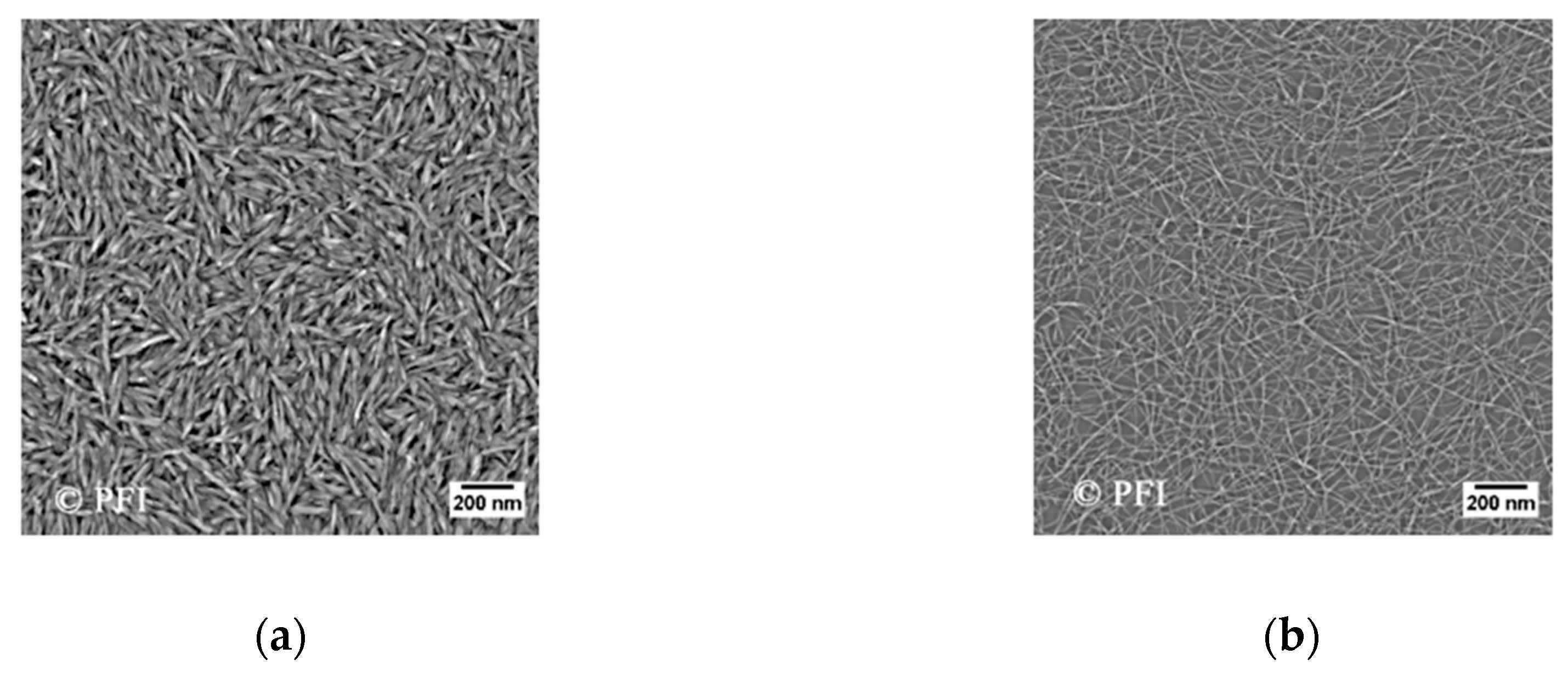
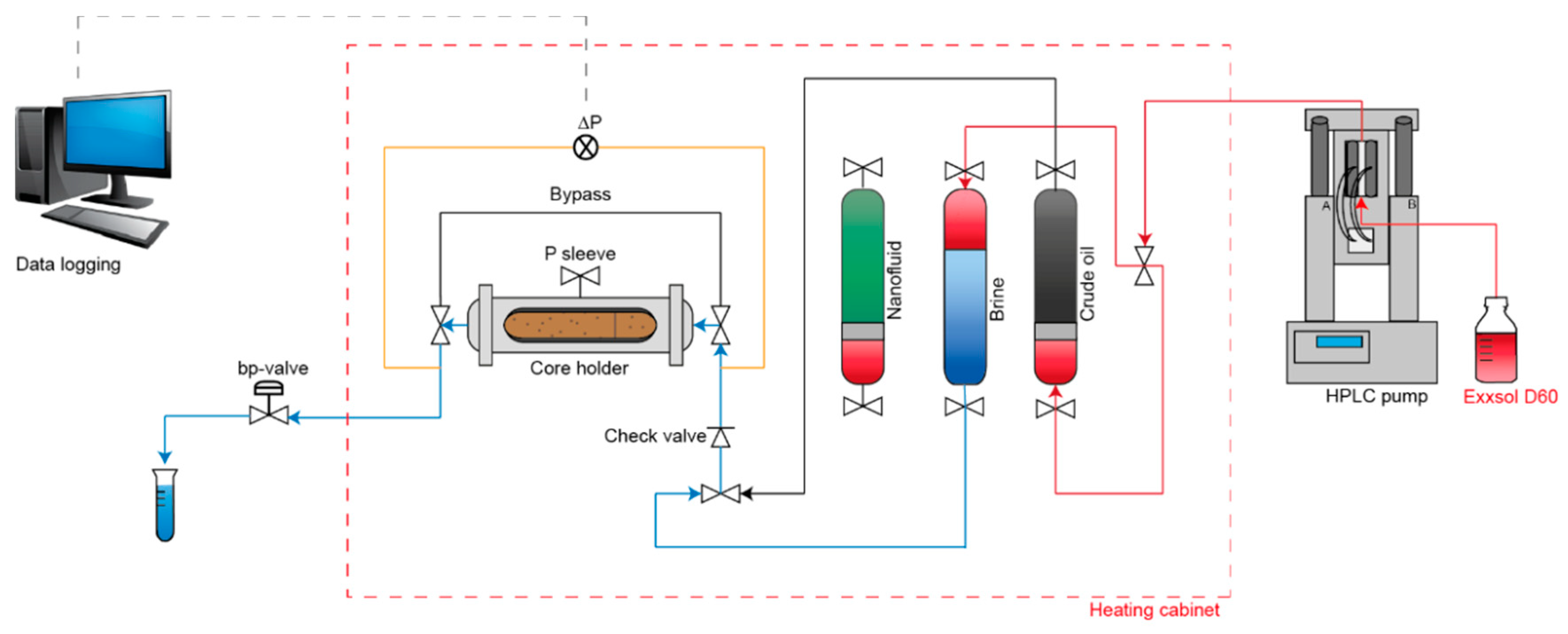
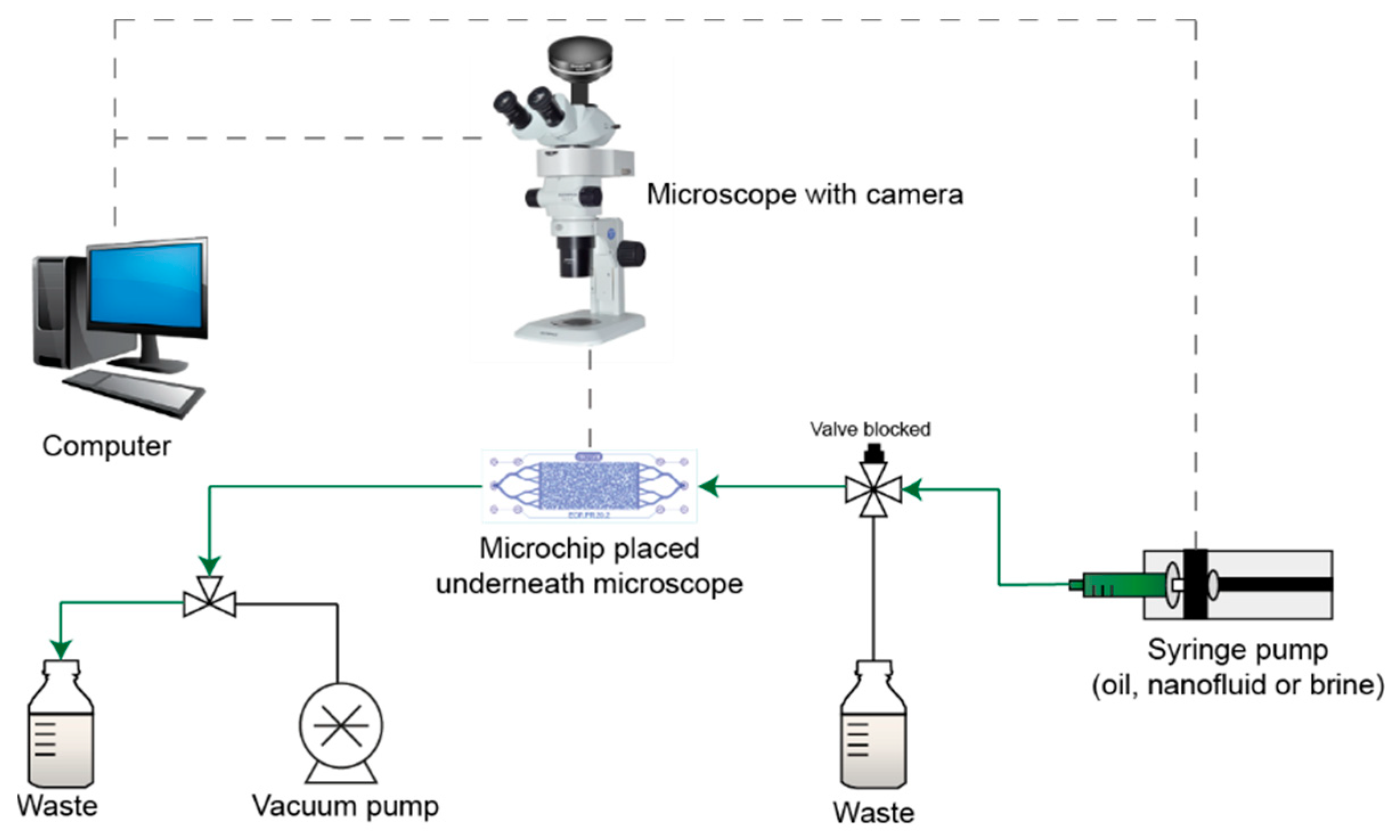

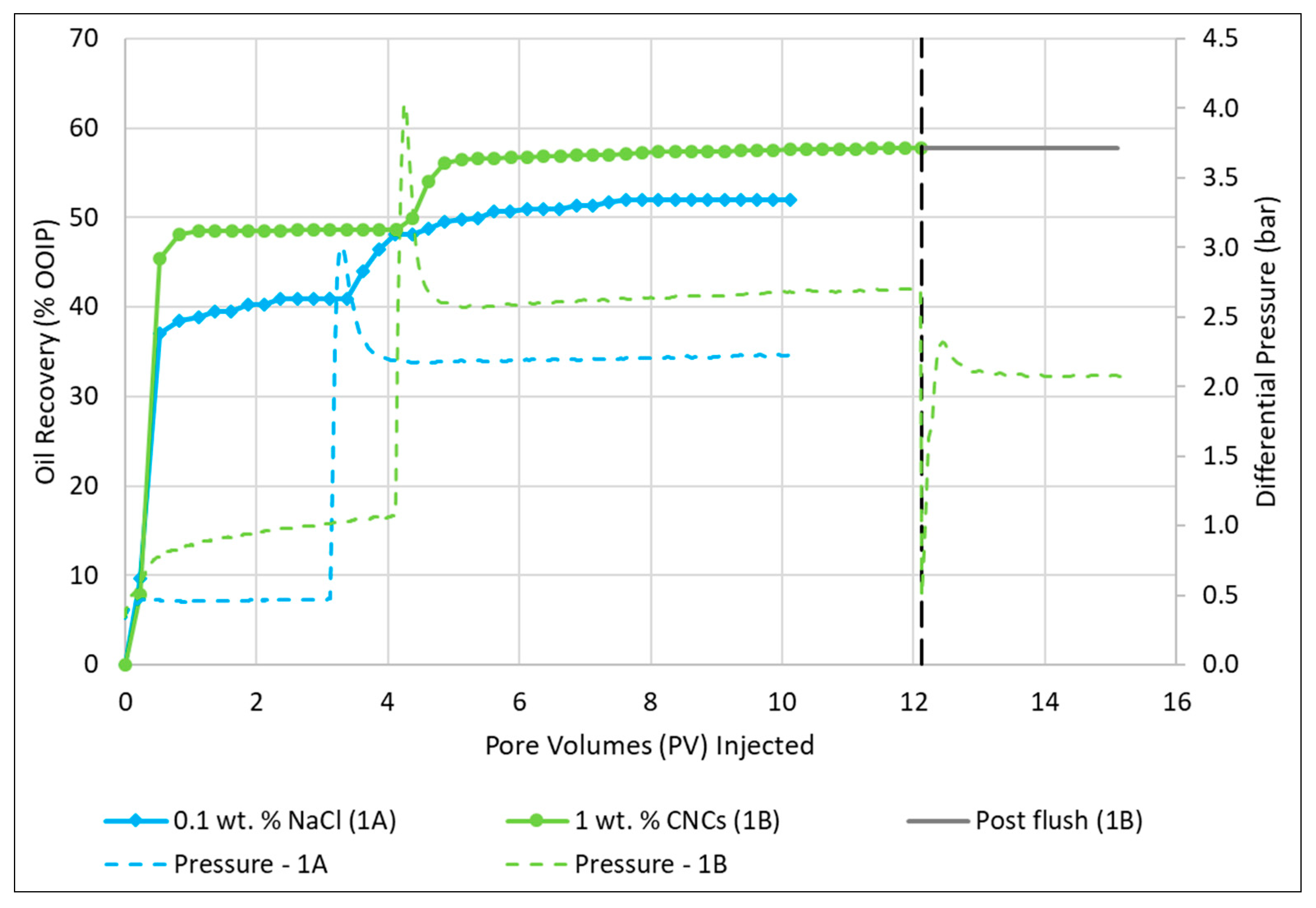
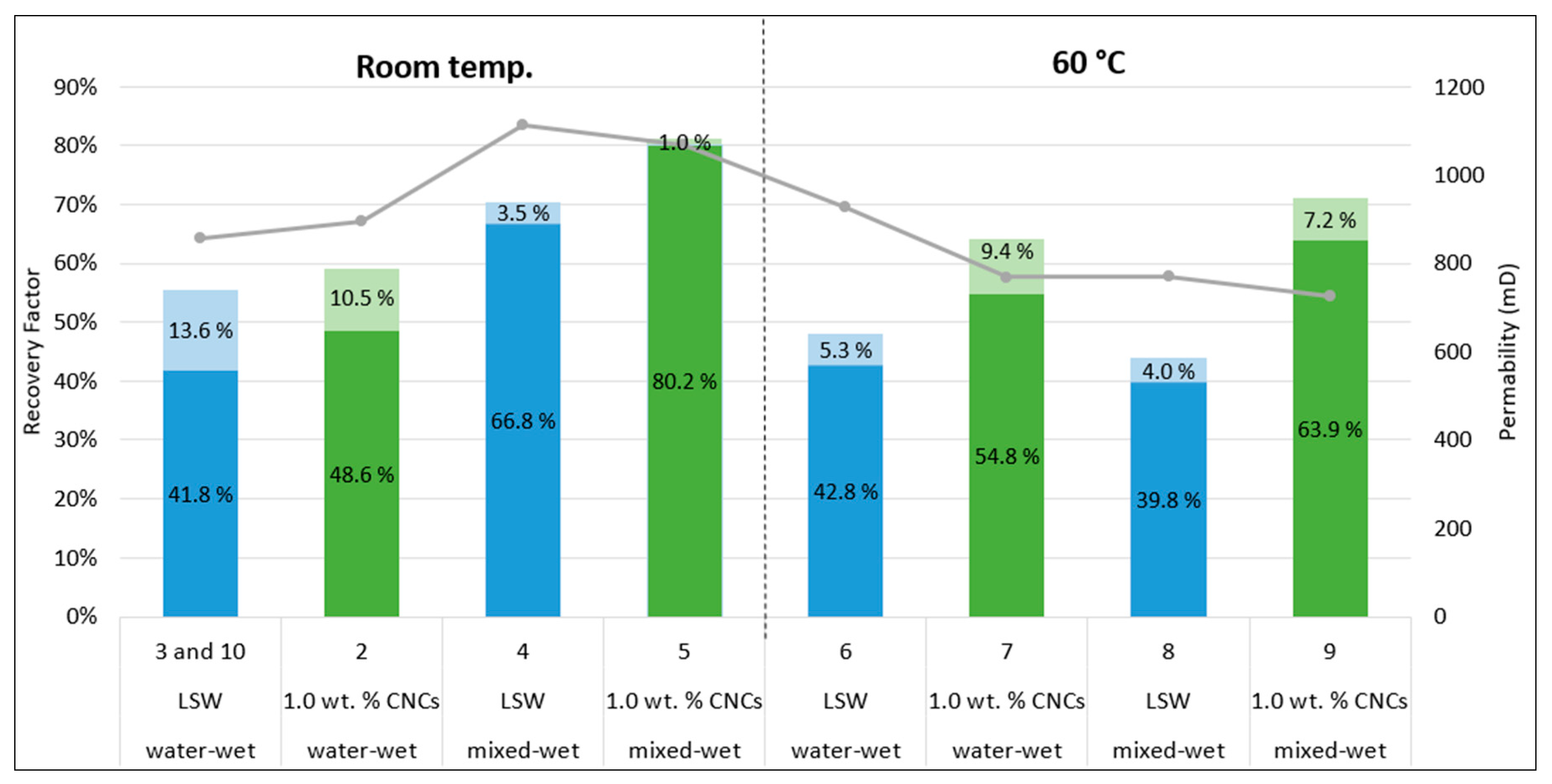
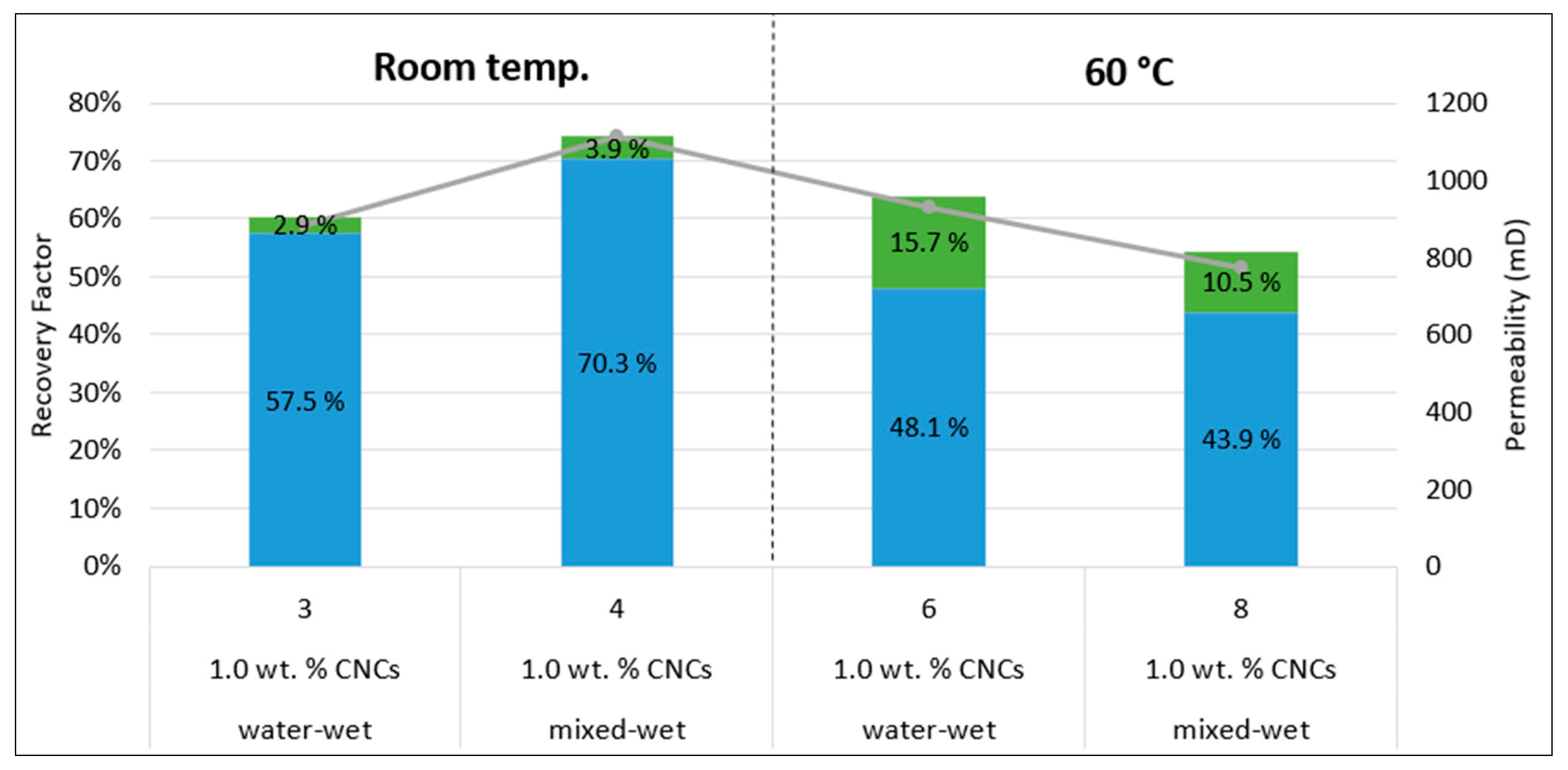
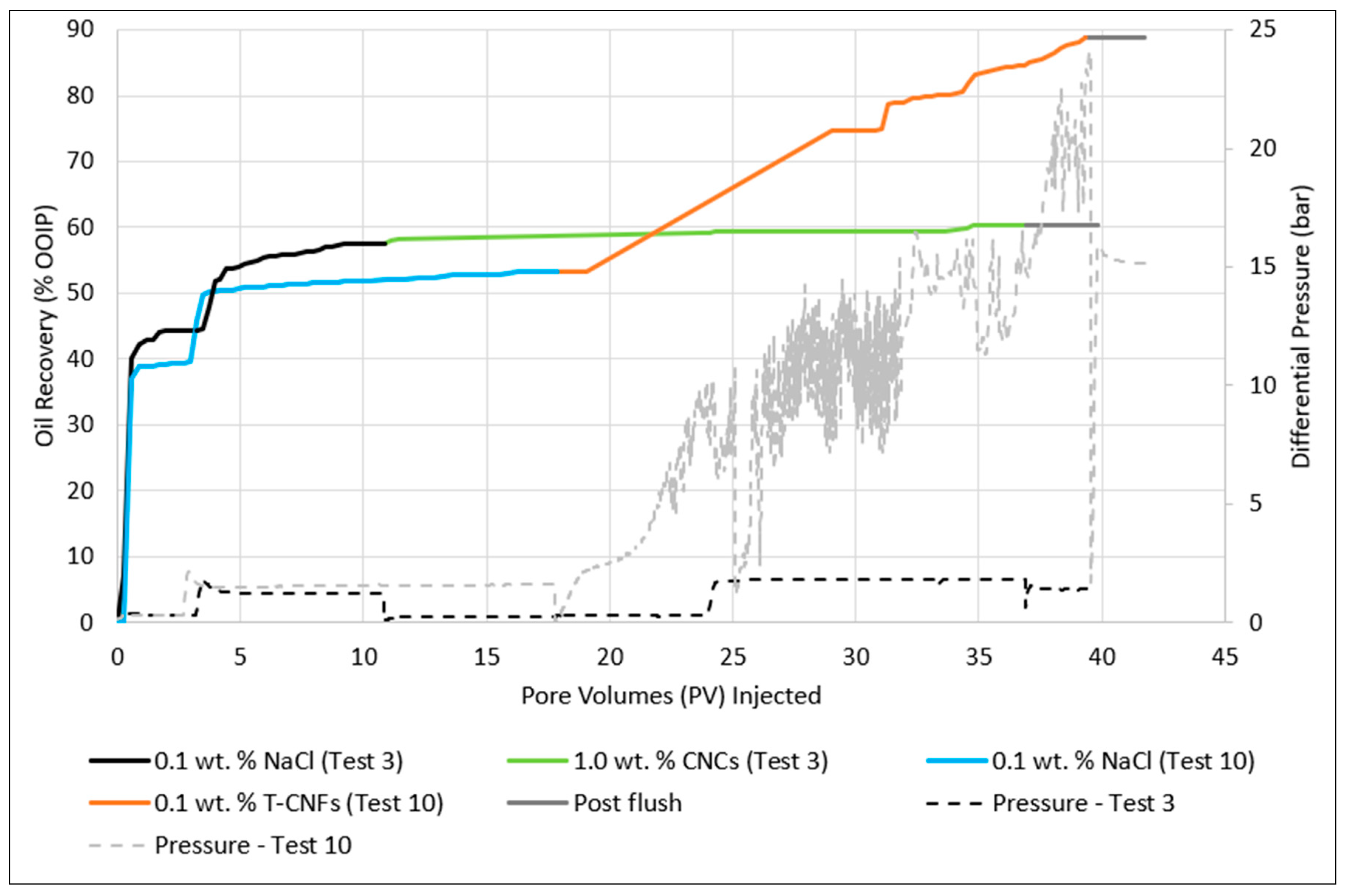
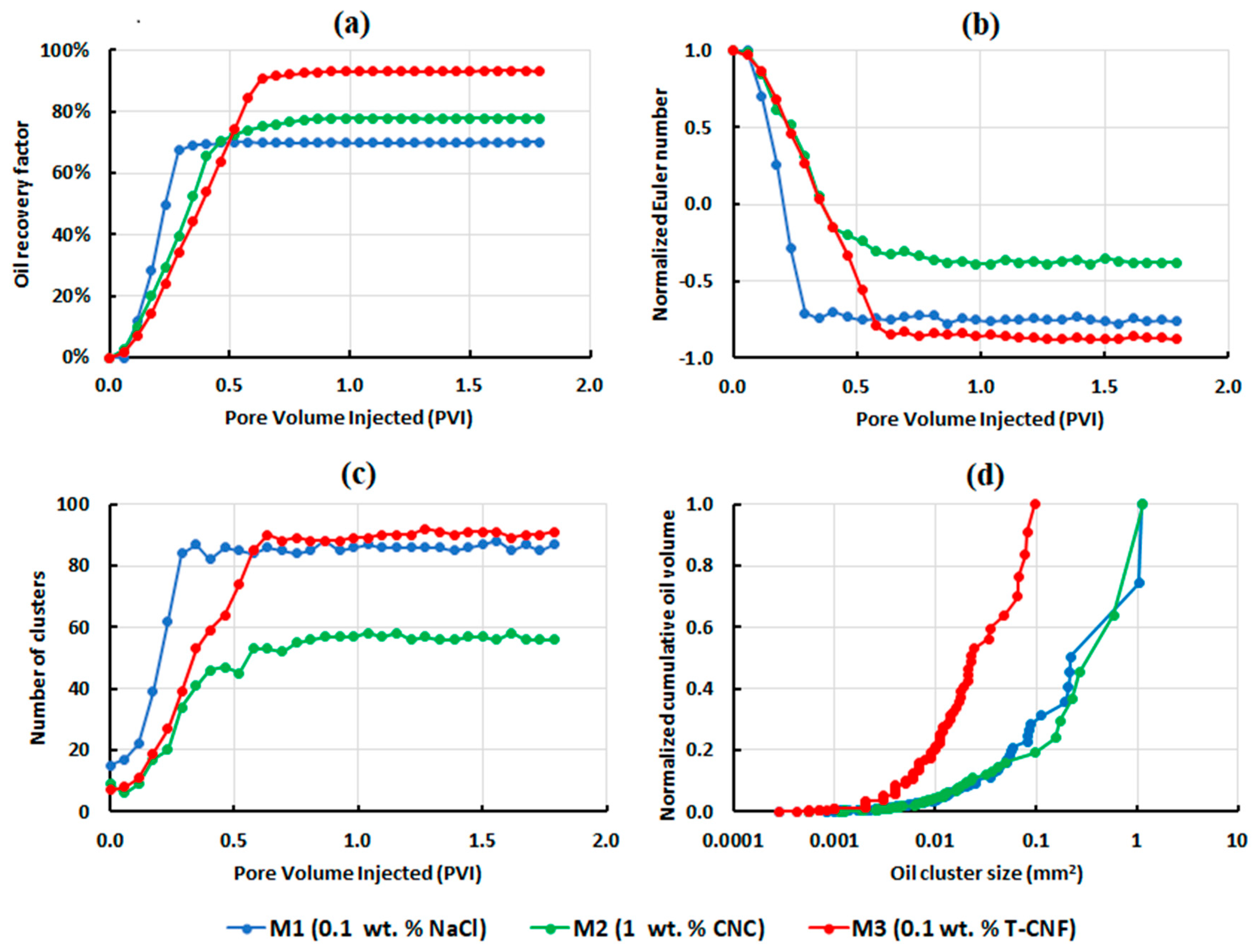
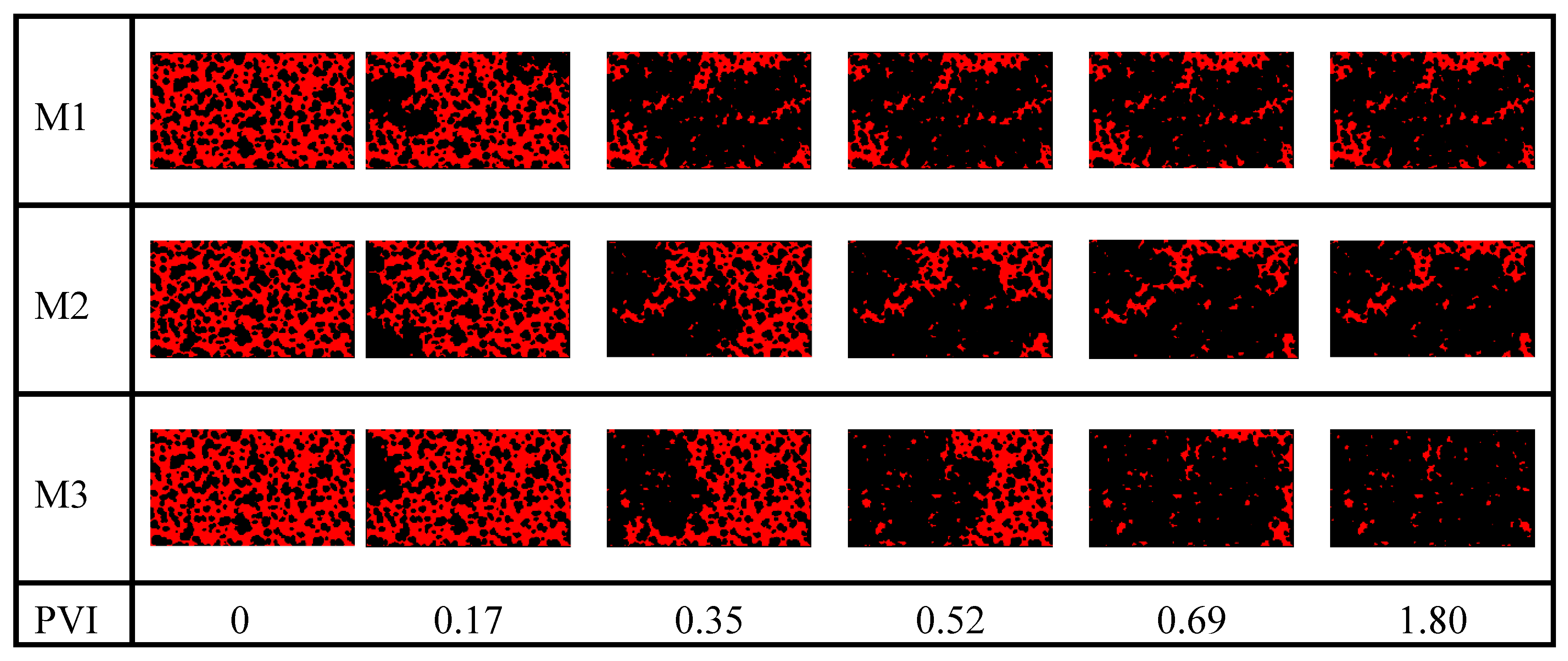

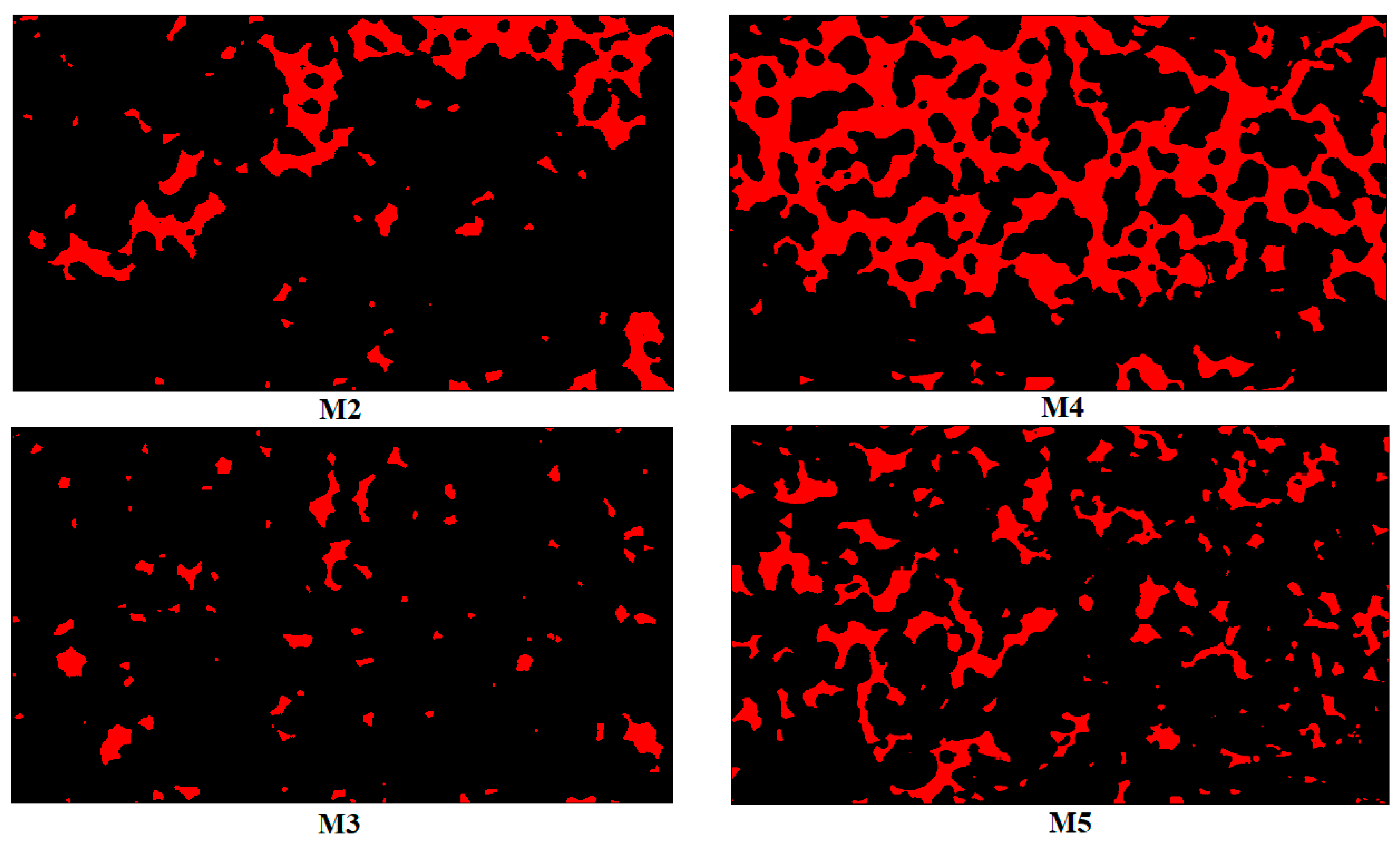
| Core | Length | Diameter | Pore Volume | Permeability | Porosity |
|---|---|---|---|---|---|
| (no.) | (cm) | (cm) | (mL) | (mD) | (%) |
| 1 | 10.0 | 3.8 | 19.3 | 781 | 17.5 |
| 2 | 10.0 | 3.7 | 18.3 | 896 | 15.1 |
| 3 | 9.9 | 3.8 | 17.5 | 883 | 15.9 |
| 4 | 9.7 | 3.8 | 18.4 | 1111 | 17.1 |
| 5 | 9.9 | 3.8 | 18.5 | 1067 | 16.9 |
| 6 | 9.9 | 3.8 | 18.8 | 928 | 17.2 |
| 7 | 9.9 | 3.8 | 18.8 | 768 | 17.2 |
| 8 | 9.9 | 3.8 | 18.1 | 771 | 16.5 |
| 9 | 9.9 | 3.8 | 18.3 | 727 | 16.8 |
| 10 | 9.9 | 3.8 | 17.5 | 832 | 16.0 |
| Fluid | Density (g/cm3) | Viscosity (cP) | ||
|---|---|---|---|---|
| 24 °C | 60 °C | 24 °C | 60 °C | |
| 0.1 wt.% NaCl | 1.00 | 0.98 | 0.91 | 0.47 |
| 1 wt.% CNCs in 0.1 wt.% NaCl | 1.00 | 1.01 | 1.40 | 1.09 |
| 0.5 wt.% CNCs in 0.1 wt.% NaCl | 0.99 | 1.00 | 1.33 | 1.24 |
| 0.1 wt.% T-CNFs in 0.1 wt.% NaCl | 1.01 | - | 3.67 | - |
| Crude oil C | 0.91 | 0.89 | 55.90 | 12.19 |
| Crude oil D | 0.89 | 0.87 | 20.74 | 5.88 |
| Sample | Charge Density * (mmol/g) | Functional Groups in Significant Amounts | Zeta Potential | Apparent Size by DLS (nm) |
|---|---|---|---|---|
| CNCs | approx. 0.3 ** | –OH, –SO3H | −40.1 ± 2.5 | 123 ± 0–164 ± 2 nm |
| T-CNFs | 1.13 | –OH, –COOH, –CHO | −41.7 ± 2.2 | 1019 ± 297 nm |
| Type of Oil | Weight Percent (Normalized) | |||
|---|---|---|---|---|
| Saturates | Aromatics | Resins | Asphaltenes | |
| Crude oil C | 66.21 | 25.78 | 7.69 | 0.32 |
| Crude oil D | 71.57 | 20.81 | 7.44 | 0.18 |
| Part | Test No. | Fluids | Conditions | |||
|---|---|---|---|---|---|---|
| Secondary Agent | Tertiary Agent | Oleic Phase | Temp. (°C) | Aging Time (Weeks) | ||
| 1 | 1A | 0.1 wt.% NaCl | - | Crude oil C | 24 | - |
| 1B | 1.0 wt.% CNCs | - | - | |||
| 2 | 2 | 1.0 wt.% CNCs | - | - | ||
| 3 | 0.1 wt.% NaCl | 1.0 wt.% CNCs | Crude oil D | - | ||
| 4 | 0.1 wt.% NaCl | 1.0 wt.% CNCs | 5 | |||
| 5 | 1.0 wt.% CNCs | - | 5 | |||
| 6 | 0.1 wt.% NaCl | 1.0 wt.% CNCs | 60 | - | ||
| 7 | 1.0 wt.% CNCs | - | - | |||
| 8 | 0.1 wt.% NaCl | 1.0 wt.% CNCs | 5 | |||
| 9 | 1.0 wt.% CNCs | - | 7 | |||
| 3 | 10 | 0.1 wt.% NaCl | 0.1 wt.% T-CNF | 24 | - | |
| Test No. | Recovery Agent | Flow Rate (µL/min) | Capillary Number | Duration (min) | Pore Volume Injected | Analyzed Area (mm2) | Image Number |
|---|---|---|---|---|---|---|---|
| M1 | 0.1 wt.% NaCl | 0.18 | 1.2 × 10−6 | 23.0 | 1.8 | 28.1 | 31 |
| M2 | 1.0 wt.% CNCs | 2.1 × 10−6 | |||||
| M3 | 0.1 wt.% T-CNFs | 5.0 × 10−6 | |||||
| M4 | 1.0 wt.% CNCs | 1.80 | 2.1 × 10−5 | 10.2 | 8.0 | 25 | |
| M5 | 0.1 wt.% T-CNFs | 5.0 × 10−5 |
| Fluid | Interfacial Tension (mN/m) | Contact Angle (°) | ||
|---|---|---|---|---|
| Crude Oil C | Crude Oil D | Crude Oil C | Crude Oil D | |
| 0.1 wt.% NaCl | 19.2 ± 0.02 | 15.3 ± 0.03 | 49.6 ± 0.2 | 52.5 ± 0.8 |
| 1.0 wt.% CNCs | 16.9 ± 0.02 | 13.8 ± 0.05 | 52.0 ± 0.1 | 56.1 ± 0.2 |
| 0.1 wt.% T-CNFs | 19.1 ± 0.07 | 15.4 ± 0.03 | 51.1 ± 0.1 | 60.3 ± 0.1 |
| Fluid | Capillary Number for Core Floods | |||
|---|---|---|---|---|
| Crude Oil C | Crude Oil D | |||
| 0.3 mL/min | 3.0 mL/min | 0.3 mL/min | 3.0 mL/min | |
| 0.1 wt.% NaCl | 1.23 × 10−6 | 1.23 × 10−5 | 1.6 × 10−6 * | 1.6 × 10−5 * |
| 1.0 wt.% CNCs | 2.50 × 10−6 | 2.50 × 10−5 | 2.7 × 10−6 * | 2.7 × 10−5 * |
| 0.1 wt.% T-CNFs | - | - | 6.0 × 10−6 | 6.0 × 10−5 |
| Core | New Pore Volume | Porosity (%) | Permeability (mD) | Reduction Perm. | ||
|---|---|---|---|---|---|---|
| (mL) | Before | After | Before | After | (%) | |
| 1 | 19.2 | 17.5 | 17.3 | 781 | 731 | 6.5 |
| Part | Test No. | Fluids | Conditions | Incremental Recovery Factor of OOIP (%) | Total Recovery (%) | |||||||
|---|---|---|---|---|---|---|---|---|---|---|---|---|
| Secondary Agent | Tertiary Agent | Crude Oil Type | T | Aging Time | Swi | Secondary Agent | Tertiary Agent | |||||
| (°C) | (Weeks) | (Fraction) | Qlow | Qhigh | Qlow | Qhigh | ||||||
| 1 | 1A | 0.1 wt.% NaCl | - | C | 24 | - | 0.247 | 40.9 | 11.1 | - | - | 52.0 |
| 1B | 1.0 wt.% CNCs | - | - | 0.241 | 48.6 | 9.2 | - | - | 57.8 | |||
| 2 | 2 | 1.0 wt.% CNCs | - | - | 0.314 | 48.6 | 10.5 | - | - | 59.0 | ||
| 3 * | 0.1 wt.% NaCl | 1.0 wt.% CNCs | D | - | 0.306 | 44.3 | 13.2 | 1.7 | 1.2 | 60.4 | ||
| 4 | 0.1 wt.% NaCl | 1.0 wt.% CNCs | 5 | 0.308 | 66.8 | 3.5 | 3.6 | 0.3 | 74.2 | |||
| 5 | 1.0 wt.% CNCs | - | 5 | 0.302 | 80.2 | 1.0 | - | - | 81.2 | |||
| 6 | 0.1 wt.% NaCl | 1.0 wt.% CNCs | 60 | - | 0.407 | 42.8 | 5.3 | 9.4 | 6.3 | 63.8 | ||
| 7 | 1.0 wt.% CNCs | - | - | 0.383 | 54.8 | 9.4 | - | - | 64.2 | |||
| 8 | 0.1 wt.% NaCl | 1.0 wt.% CNCs | 5 | 0.173 | 39.8 | 4.0 | 2.7 | 7.8 | 54.4 | |||
| 9 | 1.0 wt.% CNCs | - | 7 | 0.311 | 63.9 | 7.2 | - | - | 71.1 | |||
| 3 | 10 | 0.1 wt.% NaCl | 0.1 wt.% T-CNFs | 24 | - | 0.411 | 39.4 | 14.0 | 25.5 | 9.9 | 88.7 | |
| 3 | 0.1 wt.% NaCl | 1.0 wt.% CNCs | - | 0.306 | 44.3 | 13.2 | 1.7 | 1.2 | 60.4 | |||
© 2020 by the authors. Licensee MDPI, Basel, Switzerland. This article is an open access article distributed under the terms and conditions of the Creative Commons Attribution (CC BY) license (http://creativecommons.org/licenses/by/4.0/).
Share and Cite
Aadland, R.C.; Akarri, S.; Heggset, E.B.; Syverud, K.; Torsæter, O. A Core Flood and Microfluidics Investigation of Nanocellulose as a Chemical Additive to Water Flooding for EOR. Nanomaterials 2020, 10, 1296. https://doi.org/10.3390/nano10071296
Aadland RC, Akarri S, Heggset EB, Syverud K, Torsæter O. A Core Flood and Microfluidics Investigation of Nanocellulose as a Chemical Additive to Water Flooding for EOR. Nanomaterials. 2020; 10(7):1296. https://doi.org/10.3390/nano10071296
Chicago/Turabian StyleAadland, Reidun C., Salem Akarri, Ellinor B. Heggset, Kristin Syverud, and Ole Torsæter. 2020. "A Core Flood and Microfluidics Investigation of Nanocellulose as a Chemical Additive to Water Flooding for EOR" Nanomaterials 10, no. 7: 1296. https://doi.org/10.3390/nano10071296
APA StyleAadland, R. C., Akarri, S., Heggset, E. B., Syverud, K., & Torsæter, O. (2020). A Core Flood and Microfluidics Investigation of Nanocellulose as a Chemical Additive to Water Flooding for EOR. Nanomaterials, 10(7), 1296. https://doi.org/10.3390/nano10071296






